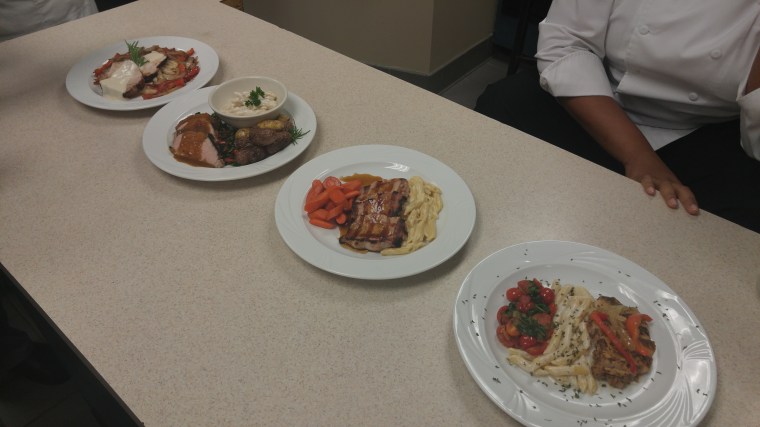My second semester of culinary school is moving at an exciting pace. I’m finally beginning to feel comfortable in the professional kitchen, getting my bearings and learning how to use the large scale equipment. I’m taking two classes this fall: Principles of Cooking and Principles of Baking, and my two books together weigh nearly 13 pounds! Would you believe I’ve already gotten my first kitchen “scar?” It was a total rookie mistake.

When tasting for seasonings a blonde roux, that is, equal parts butter and flour cooked to the proper color and used to thicken sauces, I became so enamored with the texture and color of the thickener, that I completely dismissed the fact that the stockpot had just come from a medium-heat gas flame. Excited that my group’s roux had reached the proper consistency, with my finger I swiped the back of my stirring spoon for a quick taste. Ouch! My memory returned immediately when my skin touched the hot concoction and I may or may not have lost my religion right there next to the stove.

Over the past three weeks, my cooking class has covered stocks, soups and stews. From scratch, we’ve made chicken, veal and fish stocks with a Sachet d’Epices which literally translates, bag of spices. Parsley stems, bay leaves, fresh thyme and peppercorns are wrapped in a small cheesecloth sack and secured with kitchen twine, tied to the handle of the pot and draped directly over the side and into the liquid. The herbs and spices add an earthy depth of flavor to an otherwise bland stock.
I’ve learned to cook the five French mother sauces: Bechamel (white sauce), Espagnole (brown sauce), Tomato, Hollandaise and Veloute (blonde sauce). With each sauce, we prepare a complimentary protein or starch for two purposes: to taste all the components together and to practice plating. When working in the kitchen, our class of about 16 students is split into groups of four. Each group is tasked with a deadline of presenting a plate to be critiqued on flavor, visual interest and portion size by our instructor.

With the fresh tomato sauce, we used eggplant and basil from our garden, and made large batches of eggplant parmesan. With the Espagnole, we grilled pork and served the brown sauce right over the top. With our Bechamel, a milk-based sauce thickened with a white roux, we added fresh cheeses thereby creating a derivative of Bechamel called Mornay, then tossed the creamy sauce with al dente penne pasta. The Hollandaise, an emulsion of egg yolk and liquid butter whisked into submission, was beautiful over Eggs Benedict: toasted bread, pan-fried ham and a perfectly cooked poached egg. I am satisfied to say, my instructor, Executive Chef Alex, said my group produced a “perfect” Eggs Benedict. Our Espagnole sauce over grilled pork was best in class. As for the Bechamel with pasta, we garnished our dish with a whole sprig of parsley instead of chopping it and Chef Alex commented, “1980 called and wants their garnish back.” I guess you can’t win them all.

While Tropical Storm Hermine canceled week two of my Principles of Baking class, we’ve already baked soft white dinner rolls and cracked wheat bread with dried cranberries. The process of activating fresh yeast, mixing it in batter and waiting for dough to double in size is quite fun. Pounding out the dough is a sure stress reliever, and rolling it to the proper smoothness is truly an art. After that comes proofing, then scoring and finally baking.

Bread knots have also been an enlightening exercise. With dough, I now know how to execute a single, double and three-braid knot. We eat with our eyes first and presentation makes all the difference. My instructor, Chef Szabo, says, “Baking is a science and a chemistry. That’s what makes us different.”
Over the summer, I came out on top of my classes with straight A’s. I even made the Dean’s List and passed my National Restaurant Association ServSafe Certification exam. I’m hoping to keep that momentum going this semester, with all my fingers intact.
This article will appear in the Statesboro Herald on Sunday, Sept. 11, 2016.
New to Some Kinda Good?
 Let’s work together! Email me
Let’s work together! Email meat SKGFoodBlog@gmail.com.
Georgia native Rebekah Faulk Lingenfelser is a freelance writer, entertainer and food enthusiast who writes and speaks about her love of good food and the Coastal South. A Season 2 Contestant on ABC TV’s “The Taste,” she is the Statesboro Herald food columnist and past host of the program “Statesboro Cooks.” Lingenfelser is a student at the award-winning Culinary Institute of Savannah. To learn more, visit RebekahFaulk.wix.com/RebekahFaulk or connect with Rebekah on social media by following Some Kinda Good on Facebook, Twitter and Instagram.












